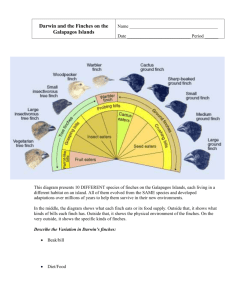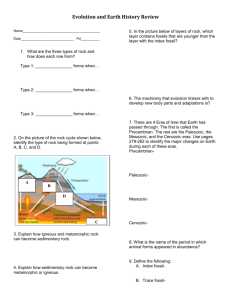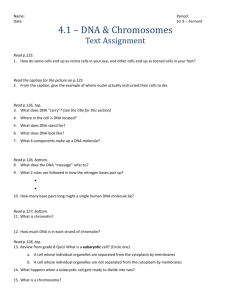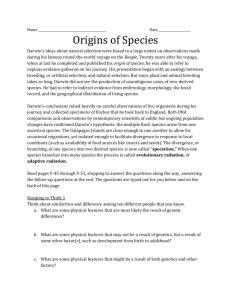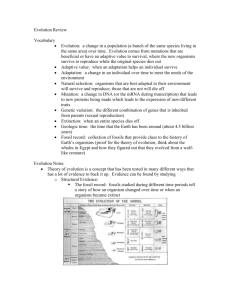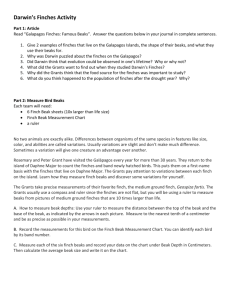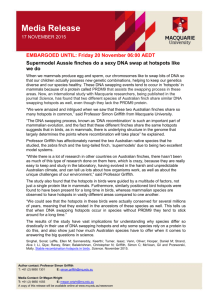Test 9
advertisement
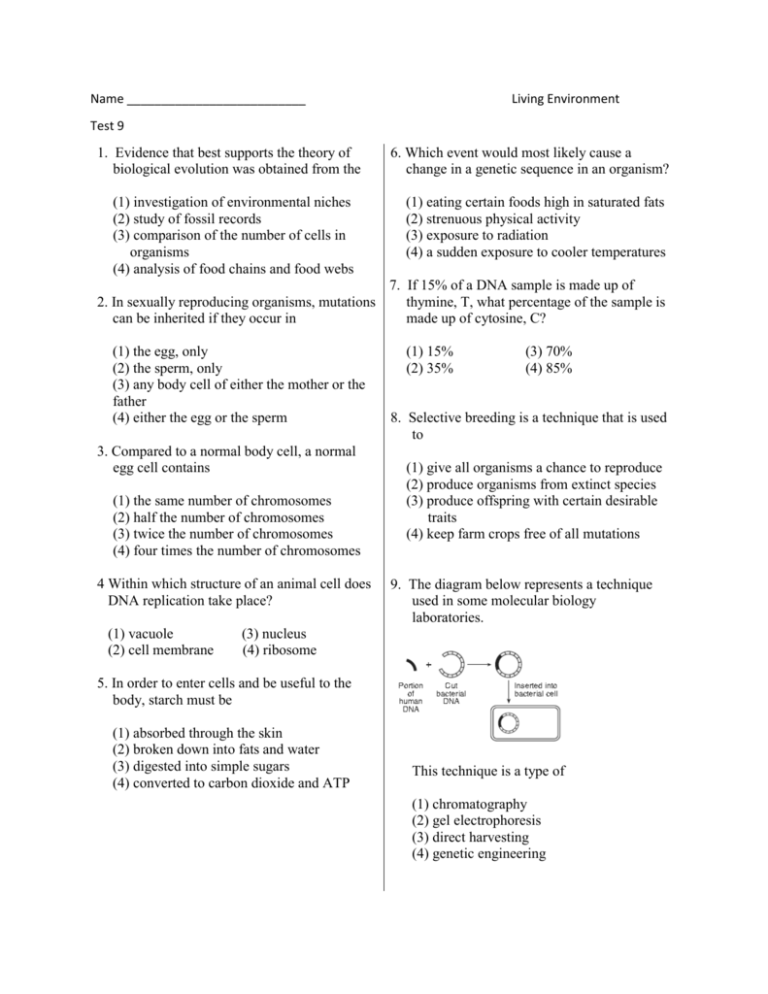
Name __________________________ Living Environment Test 9 1. Evidence that best supports the theory of biological evolution was obtained from the (1) investigation of environmental niches (2) study of fossil records (3) comparison of the number of cells in organisms (4) analysis of food chains and food webs 6. Which event would most likely cause a change in a genetic sequence in an organism? (1) eating certain foods high in saturated fats (2) strenuous physical activity (3) exposure to radiation (4) a sudden exposure to cooler temperatures 7. If 15% of a DNA sample is made up of 2. In sexually reproducing organisms, mutations thymine, T, what percentage of the sample is can be inherited if they occur in made up of cytosine, C? (1) the egg, only (2) the sperm, only (3) any body cell of either the mother or the father (4) either the egg or the sperm 3. Compared to a normal body cell, a normal egg cell contains (1) the same number of chromosomes (2) half the number of chromosomes (3) twice the number of chromosomes (4) four times the number of chromosomes 4 Within which structure of an animal cell does DNA replication take place? (1) vacuole (2) cell membrane (1) 15% (2) 35% (3) 70% (4) 85% 8. Selective breeding is a technique that is used to (1) give all organisms a chance to reproduce (2) produce organisms from extinct species (3) produce offspring with certain desirable traits (4) keep farm crops free of all mutations 9. The diagram below represents a technique used in some molecular biology laboratories. (3) nucleus (4) ribosome 5. In order to enter cells and be useful to the body, starch must be (1) absorbed through the skin (2) broken down into fats and water (3) digested into simple sugars (4) converted to carbon dioxide and ATP This technique is a type of (1) chromatography (2) gel electrophoresis (3) direct harvesting (4) genetic engineering 10. The diagram below represents the bone arrangements in the front limbs of three different species of mammals. The similarities and differences in these limbs suggest that all three species developed from the same ancestor, but (1) produced different numbers of offspring (2) lived in different time periods (3) adapted to different habitats (4) migrated to similar habitats 11. The arrows in the diagram below indicate the development of four different varieties of vegetable plants from wild mustard. Each of these varieties was most likely produced as a result of (1) asexual reproduction in the wild for many years (2) changes in light availability (3) competition between plants (4) selective breeding over many generations 12. Four different segments of a DNA molecule are represented below. Segment 1 T–A–G–G–C A–T–C–C–G Segment 2 G–G–T–G–A C–C–A–C–T Segment 3 G–A–T–T–A C–C–A–A–T Segment 4 C–A–A–T–G G–T–T–A–C There is an error in the DNA molecule in (1) segment 1, only (2) segment 3, only (3) segments 2 and 3 (4) segments 2 and 4 Base your answers to questions 13 through 15 on the information and diagram below and on your knowledge of biology. Samples of DNA from an eye-color gene of four individuals, W, X, Y, and Z, were cut into pieces using a type of chemical. The results of this procedure are shown below. 13. Identify the specific type of chemical used to cut the DNA in this procedure. [ 1] ___________________________________ 14. Which two individuals have DNA base patterns for this gene that are the most similar? Support your answer. [1] Individuals: ________________ and ________________ _________________________________________________________________________________ _________________________________________________________________________________ 15. The diagram represents the results of the procedure known as (1) cloning (2) chromatography (3) gel electrophoresis (4) protein sequencing 16. The diagrams below represent seeds taken from a carrot plant and seeds taken from plant species 1, 2, and 3. Which species would be expected to be most similar to the carrot? Support your answer. [ 1] Species __________ ____________________________________________________________________ 17. Modern dogs are direct descendants of the gray wolf. They first appeared about 130,000 years ago. Today, there are about 150 different breeds of domestic dog, a few of which are shown below. The great variety of modern dogs can best be explained by (1) selective breeding of dogs over many years (2) the cloning of domestic dogs (3) genetic alterations in gray wolves alive today (4) natural selection favoring wolves over dogs 18. The diagram below represents the same field of mice hunted by a hawk over a period of three months. The overall changes in the population of mice can be explained best by (1) natural selection (2) succession (3) reproduction (4) mouse extinction The segments represent the same region of DNA that codes for a particular pigment (color) in these species. Plant Species A: ACCGCAGGGATTCGC Plant Species B: ACCGGAGCGATTCGC 19. A restriction enzyme is used to cut the DNA from species A and B. The enzyme binds to the sequence G G G A T T and cuts between G and A. State how many cuts will be made in the DNA sequences of each species when this enzyme is used. [1] Plant species A cuts: ____________ Plant species B cuts: ____________ 20. The diagram below represents one possible evolutionary change that could have led lobe-finned fish to develop into the first amphibians. Amphibians are animals that live on land some of their life. This change from fins on the lobe-finned fish to legs and feet on the early amphibian is most likely due to (1) a sudden mutation that changed the gills of the lobe-finned fish to lungs (2) increased competition between animals that had adapted to living on the land (3) the need to move to land because of increased competition for food in the ocean (4) variations among offspring, followed by natural selection Base your answers to questions 21 and 22 on the diagram below and on your knowledge of biology. 21. Several of the Galapagos Islands are inhabited by grasshoppers, beetles, flies, bees, and butterflies. Finches that feed on these consumers would have beaks adapted for (1) probing, only (2) probing or grasping (3) crushing or probing (4) parrotlike feeding or grasping 22. Farmers on a few of the Galapagos Islands have orchards of oranges, apples, grapes, and pears. Which species of finch would consume these foods? (1) woodpecker finch (2) small ground finch (3) sharp-beaked ground finch (4) vegetarian tree finch Base your answers to questions 23 and 24 on the information and chart below and on your knowledge of biology. The Galapagos Islands are home to many different species of finches. Three finch species, their relative beak sizes, and their food preferences are represented below. All three species live on the same island 23. Which statement is correct concerning the nutritional preferences of these finches? (1) The three species do not compete for food because they eat different types of foods. (2) The vegetarian and cactus finches compete for food because they both feed on producers. (3) The vegetarian and warbler finches compete for food because they both live in trees. (4) The three species of finches compete for food because their beaks are similar in shape and size. 24. Which process allows for the evolution of finches over time? (1) natural selection (2) selective breeding . (3) asexual reproduction (4) ecological succession Name _______________________________ Test 9 1. ______ 2. ______ 3. ______ 4. ______ 5. ______ 6. ______ 7. ______ 8. ______ 9. ______ 10. _____ 11. _____ 12. _____ 13. ________________________________________________________ 14. Individuals: ___________________ and ___________________ ________________________________________________________________________________ ________________________________________________________________________________ 15. _____ 16. Species _____________ _________________________________________________________________________________ 17. ______ 18. ______ 19. Plant species A cuts: ____________ 20. ______ 21. ______ 22. ______ 23. ______ 24. ______ Plant species B cuts: ____________
